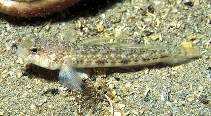| Family: |
Gobiidae (Gobies), subfamily: Gobiinae |
| Max. size: |
8 cm TL (male/unsexed) |
| Environment: |
bathydemersal; marine; depth range 320 - 385 m |
| Distribution: |
Eastern Atlantic and Mediterranean Sea. |
| Diagnosis: |
Distinguished by the following characteristics: D1 VI, D2 I/I 1 - 12, A 1/11, P 17 - 18, C 16 - 17 principle rays (adult specimen with 13 branched rays; branching of fin rays not completed in the juvenile specimen); all rays of the first dorsal fin are elongated in the adult specimen (tips pronounced in the juvenile), with D1 III longest. ctenoid scales; LL 37, including scales on caudal fin (squamation not completely developed in juvenile specimen), TR 8; head, nape, predorsal area, breast, ventral side of abdomen (midline) and base of P naked; area anterior of a line from the dorsal origin of the pectoral fin to the origin of the second dorsal fin naked; anterior most scales in lateral midline reach the base of the pectoral fin in the adult specimen (only near to it in the juvenile); some of these most anterior scales are cycloid (Ref. 86376) |
| Biology: |
Occurs inshore in the Mediterranean but found in deeper waters off Portugal (Ref. 4696). |
| IUCN Red List Status: |
Least Concern (LC); Date assessed: 12 March 2014 Ref. (130435)
|
| Threat to humans: |
harmless |
Source and more info: www.fishbase.org. For personal, classroom, and other internal use only. Not for publication.
